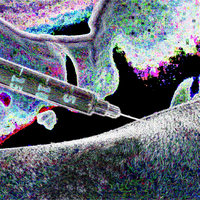| Strychnine | |
|---|---|
| Salts [] | |
|---|---|
| Sulfate | |
| Tartrate | |
| Nitrate | |
| Arsenate | |
| Hydrochloride | |
| Hypophosphite | |
| Valerate | |
| Sulfate Pentahydrate | |
| Phosphate | |
| Molecular structure via molpic based on CDK |
| Physical properties [] | |
|---|---|
| Molecular mass | 334.4 g/mol [1] |
| Density | 1.36 at 68 °F (EPA, 1998) - Denser than water; will sink g/cm3 [1] |
| Appearance | Brilliant, colorless cubes from chloroform-ether [1] |
| Odor | Odorless [1] |
| Taste | Very bitter metallic taste [1] |
| Melting point | 514 to 554 °F (EPA, 1998) [1] |
| Boiling point | 518 ° [1] |
| Decomposition | Hazardous decomposition products formed under fire conditions - Carbon oxides, nitrogen oxides (NOx). [1] |
| Solubility | 0.02 % (NIOSH, 2024) [1] |
| Predicted LogP | 1.9 [1] |
| Structural Identifiers [] | |
|---|---|
| Molecular formula | C21H22N2O2 [1] |
| IUPAC name | (4aR,5aS,8aR,13aS,15aS,15bR)-4a,5,5a,7,8,13a,15,15a,15b,16-decahydro-2H-4,6-methanoindolo[3,2,1-ij]oxepino[2,3,4-de]pyrrolo[2,3-h]quinolin-14-one [1] |
| SMILES | C1CN2CC3=CCO[C@H]4CC(=O)N5[C@H]6[C@H]4[C@H]3C[C@H]2[C@@]61C7=CC=CC=C75 [1] |
| InChI | InChI=1S/C21H22N2O2/c24-18-10-16-19-13-9-17-21(6-7-22(17)11-12(13)5-8-25-16)14-3-1-2-4-15(14)23(18)20(19)21/h1-5,13,16-17,19-20H,6-11H2/t13-,16-,17-,19-,20-,21+/m0/s1 [1] |
| InChIKey | QMGVPVSNSZLJIA-FVWCLLPLSA-N [1] |
| Toxicity [] | |
|---|---|
| TDLo | Human - child: - oral: 24 mg/kg |
| LDLo | Human: - oral: 30 mg/kg Human - male: - oral: 30 mg/kg - oral: 5143 mg/kg Dog: - subcutaneous: 350 μg/kg Cat: - subcutaneous: 250 μg/kg - intravenous: 330 μg/kg Rabbit: - oral: 600 μg/kg - subcutaneous: 400 μg/kg Guinea pig: - subcutaneous: 3200 μg/kg Pigeon: - subcutaneous: 1 mg/kg Chicken: - oral: 30 mg/kg - subcutaneous: 3 mg/kg Duck: - subcutaneous: 1 mg/kg Frog: - oral: 2100 μg/kg - subcutaneous: 35 μg/kg Bird - domestic: - oral: 2500 μg/kg - subcutaneous: 1 mg/kg |
| LD50 | Rat: - oral: 2350 μg/kg - intraperitoneal: 1100 μg/kg - subcutaneous: 1200 μg/kg - intravenous: 582 μg/kg - intramuscular: 1400 μg/kg Mouse: - intraperitoneal: 980 μg/kg - subcutaneous: 474 μg/kg - intravenous: 410 μg/kg - intramuscular: 628 μg/kg - parenteral: 1060 μg/kg - oral: 2 mg/kg Dog: - oral: 500 μg/kg - intravenous: 800 μg/kg Cat: - oral: 500 μg/kg Rabbit: - intravenous: 400 μg/kg Pigeon: - oral: 21 mg/kg Quail: - oral: 23 mg/kg Duck: - oral: 3 mg/kg Bird - wild: - oral: 16 mg/kg |
Strychnine
Strychnine (also known as Strychnidin-10-one, Sanaseed, Mole death, Strychninum, Gopher bait, Gopher-gitter, Boomer-rid, Hare-Rid, Certox or RCRA waste number P108)
Chemistry
Salts []
Strychnine is typically found in the form of its sulfate, tartrate, nitrate, arsenate, hydrochloride, hypophosphite, valerate, sulfate pentahydrate and phosphate salts.
Stereochemistry []
Strychnine is a absolute mixture
Subjective effects
See also []
External links []
References []
National Center for Biotechnology Information. PubChem Compound Summary for CID 441071, Strychnine. Accessed August 6, 2025. https://pubchem.ncbi.nlm.nih.gov/compound/441071
U.S. Food and Drug Administration; National Center for Advancing Translational Sciences. Strychnine. UNII: H9Y79VD43J. Global Substance Registration System. Accessed August 6, 2025. https://gsrs.ncats.nih.gov/ginas/app/beta/substances/H9Y79VD43J
 Anodyne
Anodyne